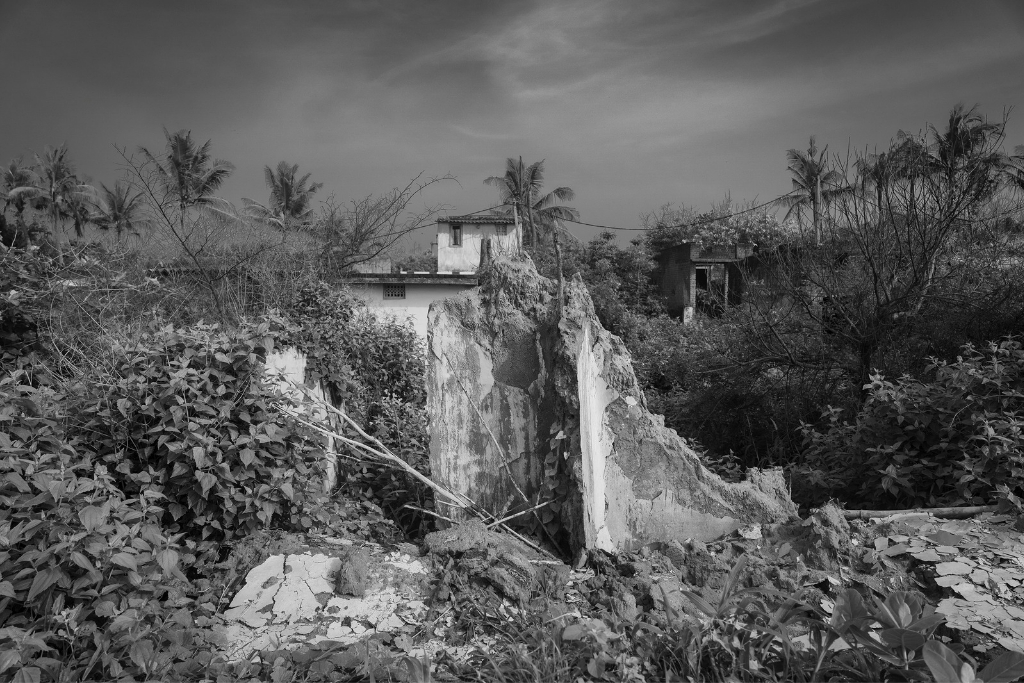
Coastal erosion takes its toll on this Odisha village
As the thriving coastal community with 200 families has been forced to abandon their houses and leave the village because of sea erosion, Podampetta in Odisha’s Ganjam district appears like a ghost village.
Podampetta, also known as the ghost village of Odisha, where walls of what used to be houses close to the beach are slowly becoming piles of debris, villagers have been abandoning their homes due to massive sea erosion in recent times. Since 2017, its residents have been migrating to nearby villages because of the shifting landscapes.
A house is seen precariously standing on the edge of the beach in Podampetta village. Odisha’s sea erosion is getting fiercer year on year, as 74 seaside settlements have been severely affected in the state, the most in all of India. A study reveals that nearly half of Odisha’s total shoreline of 480 km will face erosion by 2050.
People from the neighbouring villages gather at the ruins of Podampetta to socialise or to gaze at the sea. Once a thriving town of 200 families, only two families live here now, as they find it easier to fish from Podampetta, known as the ghost village of Odisha.
The room that once offered the view of the ocean to its inhabitants wears a desolate look, as the owners could not risk their lives and continue to live here. In most of the abandoned houses, the roof is gone as the owners deemed it valuable and took it along.
Also Read: Families along Brahmaputra lose land to river erosion
Leftover items are still seen in an abandoned kitchen in one of the houses in Podampetta. The residents were asked to migrate to other villages such as New Podampetta, where each family was given land and Rs 3 Lakh compensation.
A man sits outside a destroyed house in the ghost village, even as an abandoned TV stands testimony to the fact that people value their life the most. The increasing sea level has massively contributed to the erosion across coastal Odisha, where it has risen by 9.5 cm here, higher than the national average by 1 cm.
Also Read: Assam’s soil erosion worsening with climate change and floods
A woman cleans the small yard of her house in Podampetta, where just two families remain. The official compensation of Rs 3 lakh per family for migrating to other villages is not sufficient for families with a high headcount, says C H Paindi, a member of one of the last remaining families in the village.
Overgrown with weeds and wild plants, what was once a path is almost unrecognisable – with the dried-out coconut trees standing as sentinels.
The shoreline of Podampetta looks different, with the destroyed houses slowly falling into the sea because of erosion. Odisha is slowly turning into a hotbed of erosion, with Podampetta facing one of the maximum impacts between 1990 and 2020.
An aerial view of the abandoned village of Podampetta. Once a small bustling community of fishermen and women, it has now become a ghost village.
Also Read: India’s most haunted villages
A deserted house stands on the beach of Podampetta while a dog walks in the distance. Like Podampetta, many seaside villages in Odisha face a bleak future of destruction and migration.
The lead image on top shows Podampetta, a coastal village in Ganjam district of Odisha where remains of a house here and a garden there, overgrown with weeds and wild plants, are common sights. Almost the entire population has relocated due to extensive sea erosion.
Photos taken by Sudip Maiti.
Sudip Maiti is an independent photographer and filmmaker based out of Kolkata. He is the winner of Chennai Photo Biennale 2023.










